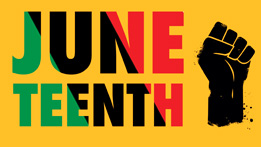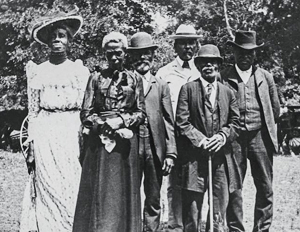 Juneteenth is the oldest known celebration of the ending of slavery. Dating back to 1865, it was on June 19 that the Union soldiers, led by Major General Gordon Granger, landed at Galveston, Texas with news that the war had ended and that the enslaved were now free.
Juneteenth is the oldest known celebration of the ending of slavery. Dating back to 1865, it was on June 19 that the Union soldiers, led by Major General Gordon Granger, landed at Galveston, Texas with news that the war had ended and that the enslaved were now free.
Note that this was two and a half years after President Lincoln’s Emancipation Proclamation – which had become official January 1, 1863 – by which Lincoln proclaimed freedom for all of the enslaved in the Confederate states.
The Emancipation Proclamation had little impact on the Texans due to the minimal number of Union troops that were needed to enforce the new executive order. However, with the surrender of General Robert E. Lee in April 1865 and the arrival of General Gordon Granger’s regiment of Union soldiers, the forces were finally strong enough to influence and overcome the resistance.
Later attempts to explain the two-and-a-half year delay in the receipt of this important news have yielded several versions that have been handed down over the years.

Often told is the story of a messenger who was murdered on his way to Texas with news of freedom.
Another is that the news was deliberately withheld by the enslavers to maintain the labor force on the plantations. And still another is that federal troops actually waited for the slave owners to reap the benefits of one last cotton harvest before going to Texas to enforce the Emancipation Proclamation.
All or none of these stories could be factual. For whatever reasons, conditions in Texas remained status quo well beyond what was statutory.
One of General Granger’s first orders of business was to read to the people of Texas, General Order Number 3, which began significantly with:
“The people of Texas are informed that in accordance with a Proclamation from the Executive of the United States, all slaves are free. This involves an absolute equality of rights and rights of property between former masters and slaves, and the connection heretofore existing between them becomes that between employer and free laborer.”
The reactions to this profound news ranged from pure shock to immediate jubilation. While many lingered to learn of this new employer to employee relationship, many left before these offers were completely off the lips of their former “masters” – attesting to the varying conditions on the plantations and the realization of freedom.
Even with nowhere to go, many fely that leaving the plantation would be their first grasp of freedom. North was the logical destination and for many it represented true freedom, while the desire to reach family members in neighboring states drove some into Louisiana, Arkansas and Oklahoma.
Settling into these new areas as free men and women brought on new realities and the challenges of establishing a heretofore non-existent status for black people in America. Recounting the memories of that great day in June of 1865 and its festivities would serve as motivation as well as release from the growing pressures encountered in their new territory.
The celebration of June 19 was dubbed “Juneteenth” and grew with more participation from descendants. The Juneteenth celebration was a time for reassuring each other, for praying and for gathering remaining family members.
Juneteenth continued to be a highly revered in Texas decades later, with many former slaves and descendants making an annual pilgrimage back to Galveston on this date.
Juneteenth Celebration Decline
Economic and cultural forces provided for a decline in Juneteenth activities and participants beginning in the early 1900’s. Classroom and textbook education in lieu of traditional family and home-taught practices stifled the interest of youth due to less emphasis and detail on the activities of former slaves.
Classroom textbooks proclaimed Lincoln’s Emancipation Proclamation of January 1, 1863 as the date signaling the end of slavery – and little or nothing on the impact of General Granger’s arrival in Texas on June 19, 1865.
The Great Depression forced many people off the farms and into cities to find work. In these urban environments, employers were less eager to grant leaves to celebrate this date. Thus, unless June 19 fell on a weekend or holiday, there were very few participants available.
July 4 was the already established Independence holiday and a rise in patriotism steered more towards this celebration.
Resurgence
The Civil Rights movement of the 1950’s and 1960’s yielded both positive and negative results for the Juneteenth celebration.
While it pulled many of the African-American youth away and into the struggle for racial equality, many linked these struggles to the historical struggles of their ancestors. This was evidenced by student demonstrators involved in the Atlanta civil rights campaign in the early 1960’s who wore Juneteenth freedom buttons.
Again in 1968, Juneteenth received another strong resurgence through the Poor People’s March to Washington, D.C. with Rev. Ralph Abernathy’s call for people of all races, creeds, economic levels and professions to come to Washington, to show support for thew poor. Many of those attendees returned home and initiated Juneteenth celebrations in areas previously absent of such activity. In fact, two of the largest Juneteenth celebrations founded after this march are now held in the far northern reaches of Milwaukee and Minneapolis.
Texas Blazes the Trail
On January 1, 1980, Juneteenth became an official state holiday through the efforts of Texas State Representative Al Edwards, an African-American legislator. The successful passage of this bill marked Juneteenth as the first emancipation celebration granted official state recognition. Representative Edwards has since actively sought to spread the observance all across America.
Juneteenth in Modern Times
Throughout the 1980’s and on into the 21st century, Juneteenth has continued to enjoy a growing and healthy interest from communities and organizations across the nation. Institutions such as the Smithsonian, the Henry Ford Museum, the Toledo Museum of Arts and others have begun sponsoring Juneteenth-centered activities.
In recent years, a number of Juneteenth organizations have arisen to take their place alongside older organizations – all with the mission to promote and cultivate knowledge and appreciation of African-American history and culture.
Juneteenth today celebrates African-American freedom while encouraging self-development and respect for all cultures. As it takes on a more national and even global perspective, the events of 1865 in Texas are not forgotten, for all of the roots tie back to this fertile soil from which a national day of pride continues to grow.
Interestingly, the orders issued on Juneteenth by General Granger applied only to Texas. Slavery didn’t end in states like Kentucky and Delaware, which hadn’t seceded and therefore weren’t covered by Lincoln’s proclamation freeing slaves in the Confederate states, until Dec. 18, 1865, when the 13th Amendment to the U. S. Constitution was adopted.
Forty-six of the 50 U.S. states and the District of Columbia have recognized Juneteenth as either a state holiday or ceremonial holiday, a day of observance. The four states that do not recognize Juneteenth are Hawaii, North Dakota, South Dakota, and Montana.
